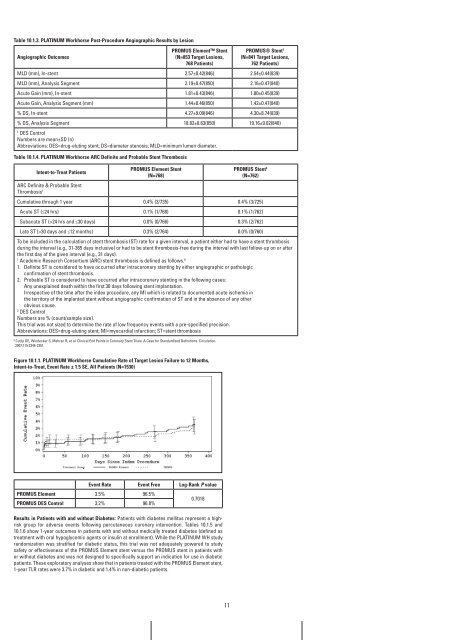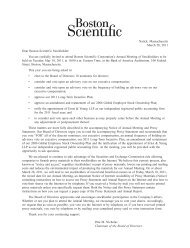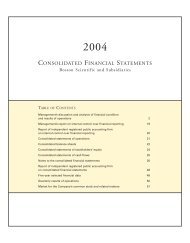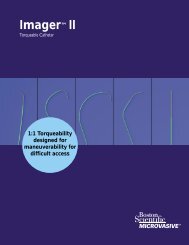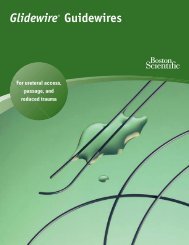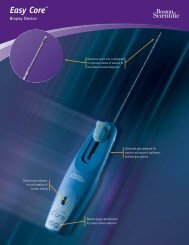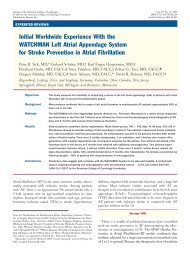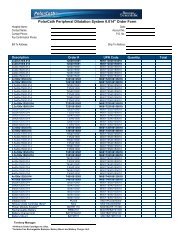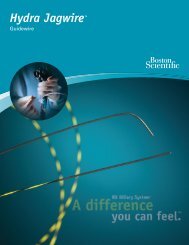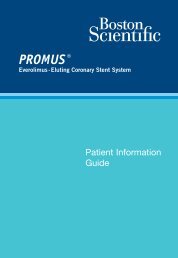PROMUS Element⢠Plus - Boston Scientific
PROMUS Element⢠Plus - Boston Scientific
PROMUS Element⢠Plus - Boston Scientific
You also want an ePaper? Increase the reach of your titles
YUMPU automatically turns print PDFs into web optimized ePapers that Google loves.
Table 10.1.3. PLaTinUM workhorse Post-Procedure angiographic results by Lesion<br />
angiographic Outcomes<br />
PrOMUS Element Stent<br />
(n=853 Target Lesions,<br />
768 Patients)<br />
11<br />
PrOMUS® Stent 1<br />
(n=841 Target Lesions,<br />
762 Patients)<br />
MLD (mm), In-stent 2.57±0.42(846) 2.54±0.44(839)<br />
MLD (mm), Analysis Segment 2.19±0.47(850) 2.16±0.47(840)<br />
Acute Gain (mm), In-stent 1.81±0.43(846) 1.80±0.45(839)<br />
Acute Gain, Analysis Segment (mm) 1.44±0.46(850) 1.42±0.47(840)<br />
% DS, In-stent 4.27±9.09(846) 4.30±8.74(839)<br />
% DS, Analysis Segment 18.82±8.63(850) 19.16±9.02(840)<br />
1 DES Control<br />
Numbers are mean±SD (n)<br />
Abbreviations: DES=drug-eluting stent; DS=diameter stenosis; MLD=minimum lumen diameter.<br />
Table 10.1.4. PLaTinUM workhorse arC Definite and Probable Stent Thrombosis<br />
intent-to-Treat Patients<br />
ARC Definite & Probable Stent<br />
Thrombosis 1<br />
PrOMUS Element Stent<br />
(n=768)<br />
PrOMUS Stent 2<br />
(n=762)<br />
Cumulative through 1 year 0.4% (3/735) 0.4% (3/725)<br />
Acute ST (≤24 hrs) 0.1% (1/768) 0.1% (1/762)<br />
Subacute ST (>24 hrs and ≤30 days) 0.0% (0/766) 0.3% (2/762)<br />
Late ST (>30 days and ≤12 months) 0.3% (2/764) 0.0% (0/760)<br />
To be included in the calculation of stent thrombosis (ST) rate for a given interval, a patient either had to have a stent thrombosis<br />
during the interval (e.g., 31-365 days inclusive) or had to be stent thrombosis-free during the interval with last follow-up on or after<br />
the first day of the given interval (e.g., 31 days).<br />
1 8<br />
Academic Research Consortium (ARC) stent thrombosis is defined as follows.<br />
1. Definite ST is considered to have occurred after intracoronary stenting by either angiographic or pathologic<br />
confirmation of stent thrombosis.<br />
2. Probable ST is considered to have occurred after intracoronary stenting in the following cases:<br />
Any unexplained death within the first 30 days following stent implantation.<br />
Irrespective of the time after the index procedure, any MI which is related to documented acute ischemia in<br />
the territory of the implanted stent without angiographic confirmation of ST and in the absence of any other<br />
obvious cause.<br />
2 DES Control<br />
Numbers are % (count/sample size).<br />
This trial was not sized to determine the rate of low frequency events with a pre-specified precision.<br />
Abbreviations: DES=drug-eluting stent; MI=myocardial infarction; ST=stent thrombosis<br />
8 Cutlip DE, Windecker S, Mehran R, et al. Clinical End Points in Coronary Stent Trials: A Case for Standardized Definitions. Circulation.<br />
2007;115:2344-2351.<br />
figure 10.1.1. PLaTinUM workhorse Cumulative rate of Target Lesion failure to 12 Months,<br />
intent-to-Treat, Event rate ± 1.5 SE, all Patients (n=1530)<br />
Event rate Event free Log-rank P value<br />
PrOMUS Element<br />
PrOMUS DES Control<br />
3.5%<br />
3.2%<br />
96.5%<br />
96.8%<br />
0.7018<br />
results in Patients with and without Diabetes: Patients with diabetes mellitus represent a highrisk<br />
group for adverse events following percutaneous coronary intervention. Tables 10.1.5 and<br />
10.1.6 show 1-year outcomes in patients with and without medically treated diabetes (defined as<br />
treatment with oral hypoglycemic agents or insulin at enrollment). While the PLATINUM WH study<br />
randomization was stratified for diabetic status, this trial was not adequately powered to study<br />
safety or effectiveness of the <strong>PROMUS</strong> Element stent versus the <strong>PROMUS</strong> stent in patients with<br />
or without diabetes and was not designed to specifically support an indication for use in diabetic<br />
patients. These exploratory analyses show that in patients treated with the <strong>PROMUS</strong> Element stent,<br />
1-year TLR rates were 3.7% in diabetic and 1.4% in non-diabetic patients.<br />
<strong>Boston</strong> <strong>Scientific</strong>, (Master Brand DFU Template 8.2677in x 11.6929in A4, 90105918AL), eDFU, MB, <strong>PROMUS</strong> Element <strong>Plus</strong>, EN, 90519100-01B


